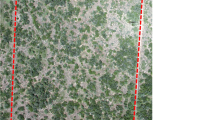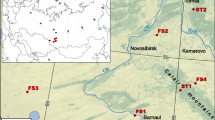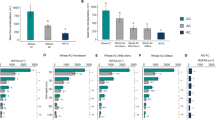Abstract
Data on the distribution of root biomass are critical to understanding the ecophysiology of vegetation communities. This is particularly true when models are applied to describe ecohydrology and vegetation function. However, there is a paucity of such information across continental Australia. We quantified vertical and horizontal root biomass distribution in a woodland dominated by Angophora bakeri and Eucalyptus sclerophylla on the Cumberland Plains near Richmond, New South Wales. The site was characterised by a duplex (texture contrast) soil with the A horizon (to 70 cm) consisting of loamy sand and the B horizon (to > 10 m) consisting of sandy clay. The topsoil had a smaller bulk density, a smaller water holding capacity but a larger organic component and a larger hydraulic conductivity in comparison to the subsoil. Root biomass was sampled to 1.5 m depth and declined through the soil profile. Whilst total biomass in the B horizon was relatively small, its contribution to the function of the trees was highly significant. Coarse roots accounted for approximately 82% of the root mass recovered. Lateral distribution of fine roots was generally even but coarse roots were more likely to occur closer to tree stems. Variation in tree diameter explained 75% of the variation in total below-ground biomass. The trench method suggested the belowground biomass was 6.03 ± 1.21 kg m−2 but this method created bias towards sampling close to tree stems. We found that approximately 68% of root material was within a 2 m radius of tree stems and this made up 54% of the total number of samples but in reality, only approximately 5 to 10% of the site is within a 2 m radius of tree stems. Based on these proportions, our recalculated belowground biomass was 2.93 ± 0.59 kg m−2. These measurements provide valuable data for modeling of ecosystem water use and productivity.




Similar content being viewed by others
References
Allen SE (1989) 'Chemical analysis of ecological materials'. pp. 368. Oxford, Blackwell Scientific
Bannerman SM, Hazelton PA (1990) Soil landscapes of the Penrith 1:100 000 sheet. Soil Conservation Service of NSW, Sydney
Barton CVM, Montagu KD (2006) Effect of spacing and water availability on root:shoot ratio in Eucalyptus camaldensis. For Ecol Manage 221:52–62
Berry SL, Farquhar GD, Roderick ML (2005) Co-evolution of climate, vegetation, soil and air. In: Blöschl G, Sivapalan M (eds) Encyclopedia of Hydrological Sciences, Volume 1: Theory, organisation and scale. Wiley, Chichester, United Kingdom, pp 177–192
Bréda N, Granier A, Barataud F, Moyne C (1995) Soil water dynamics in an oak stand. Plant Soil 172:17–27
Burgess SSO, Adams MA, Turner NC, White DA, Ong CK (2001) Tree roots: conduits for deep recharge of soil water. Oecologia 126:158–165
Chittleborough DJ (1992) Formation and pedology of duplex soils. Aust J Exp Agric 32:815–825
Collins DBG, Bras RL (2007) Plant Rooting Strategies in Water-Limited Ecosystems. Water Resour Res 43
Eamus D, Chen X, Kelley G, Hutley LB (2002) Root biomass and root fractal analyses of an open Eucalyptus forest in a savanna of north Australia. Aust J Bot 50:31–41
Fisher RA, Williams M, Do Vale RL, Da Costa AL, Meir P (2006) Evidence from Amazonian forests is consistent with isohydric control of leaf water potential. Plant Cell Environ 29:151–165
Fuentes S, Palmer AR, Taylor D, Zeppel M, Whitley R, Eamus D (2008) An automated procedure for estimating the leaf area index (LAI) of woodland ecosystems using digital imagery, MATLAB programming and its application to an examination of the relationship between remotely sensed and field measurements of LAI. Funct Plant Biol 35:1070–1079
Guswa AJ, Celia MA, Rodriguez-Iturbe I (2004) Effects of vertical resolution on predictions of transpiration in water-limited ecosystems. Ad Water Resour 27:467–480
Jackson RB, Canadell J, Ehleringer JR, Mooney HA, Sala OE, Schulze ED (1996) A global analysis of root distributions for terrestrial biomes. Oecologia 108:389–411
Janos DP, Scott J, Bowman DMJS (2008) Temporal and spatial variation of fine roots in a northern Australian Eucalyptus tetrodonta savanna. J of Trop Ecol 24:177–188
Komiyama A, Ogino K, Aksornkoae S, Sabhasri S (1987) Root biomass of a mangrove forest in southern Thailand. 1. Estimation by the trench method and the zonal structure of root biomass. J of Trop Ecol 3:97–108
Low AB, Lamont BB (1990) Arial and below-ground phytomass of Banksia scrub-heath at Eneabba, south-western Australia. Aust J Bot 38:351–359
Macfarlane C, Arnd SK, Livesley SJ, Edgar AC, White DA, Adams MA, Eamus D (2007) Estimation of leaf area index in eucalypt forest with vertical foliage, using cover and fullframe fisheye photography. For Ecol and Man 143:176–188
Metcalfe DB, Williams M, Aragão LEOC, da Costa ACL, de Almeida SS, Braga AP, Gonçalves PHL, de Athaydes Silva Jr J, Malhi Y, Mier P (2007) A method for extracting plant roots from soil which facilitates rapid sample processing without compromising measurement accuracy. New Phytol 174:697–703
Mokany K, Raison RJ, Prokushkin AS (2006) Critical analysis of root:shoot ratios in terrestrial biomes. Glob Change Biol 12:84–96
Montagu KD, Düttmer K, Barton CVM, Cowie AL (2005) Developing general allometric relationships for regional estimates of carbon sequestration—an example using Eucalyptus pilularis from seven contrasting sites. For Ecol Manage 204:113–127
O’Grady AP, Worledge D, Battaglia M (2005) Temporal and spatial changes in fine root distributions in a young Eucalyptus globulus stand in southern Tasmania. For Ecol Manage 214:373–383
O’Grady AP, Worledge D, Battaglia M (2006) Above- and below-ground relationships, with particular reference to fine roots, in a young Eucalyptus globulus (Labill.) stand in southern Tasmania. Trees 20:531–538
Resh SC, Battaglia M, Worledge D, Ladiges S (2003) Coarse root biomass for eucalypt plantations in Tasmania, Australia: sources of variation and methods of assessment. Trees 17:389–399
Saxton KE, Rawls WJ (2006) Soil water characteristic estimates by texture and organic matter for hydrological solutions. Soil Sci Soc Am J 70:1569–1578
Saxton KE, Rawls WJ, Romberger JS, Papendick RI (1986) Estimating generalized soil water characteristics from texture. Soil Sci Soc Am J 50:1031–1036
United States Department of Agriculture Soil Survey Staff (1993) National Soil Survey Handbook, title 430-VI. United States Department of Agriculture, Soil Conservation Service. U.S. Government Printing Office, Washington, D.C.
van Genuchten MT (1980) A closed-form equation for predicting the hydraulic conductivity of unsaturated soils. Soil Sci Soc Am J 44:892–898
Williams M, Rastetter EB, Fernandes DN, Goulden ML, Wofsy SC, Shaver GR, Melillo JM, Munger JW, Fan S-M, Nadelhoffer KJ (1996) Modelling the soil-plant-atmosphere continuum in a Quercus-Acer stand at Harvard forest: the regulation of stomatal conductance by light, nitrogen and soil/plant hydraulic properties. Plant Cell Environ 19:911–927
Williams RJ, Zerihun A, Montagu KD, Hoffman M, Hutley LB, Chen X (2005) Allometry for estimating aboveground tree biomass in tropical and subtropical eucalypt woodlands: towards general predictive equations. Aust J Bot 53:607–619
Yanai RD, Park BB, Hamburg SP (2006) The vertical and horizontal distribution of roots in northern hardwood stands of varying age. Can J For Res 36:450–459
Xu G-Q, Li Y (2008) Rooting depth and leaf hydraulic conductance in the xeric tree Haloxyolon ammoderdron growing at sites of contrasting soil texture. Funct Plant Biol 35:1234–1242
Zeppel M, Macinnis-Ng C, Palmer A, Taylor D, Whitley R, Fuentes S, Yunusa I, Williams M, Eamus D (2008) An analysis of the sensitivity of sap flux to soil and plant variables assessed for an Australian woodland using a soil-plant-atmosphere model. Funct Plant Biol 35:509–520
Zerihun A, Montagu KD, Hoffmann MB, Bray SG (2006) Patterns of below- and aboveground biomass in Eucalyptus populnea woodland communities of northeast Australia along a rainfall gradient. Ecosystems 9:501–515
Acknowledgements
We thank the staff at WSN Environmental Solutions Plc for contributing funding, providing access to the site and assistance with digging the trenches. We acknowledge the Australian Research Council for funding under the Discovery and Linkage programs, project numbers 0877722 and 0669063 respectively.
Author information
Authors and Affiliations
Corresponding author
Additional information
Responsible Editor: Tibor Kalapos.
Rights and permissions
About this article
Cite this article
Macinnis-Ng, C.M.O., Fuentes, S., O’Grady, A.P. et al. Root biomass distribution and soil properties of an open woodland on a duplex soil. Plant Soil 327, 377–388 (2010). https://doi.org/10.1007/s11104-009-0061-7
Received:
Accepted:
Published:
Issue Date:
DOI: https://doi.org/10.1007/s11104-009-0061-7




